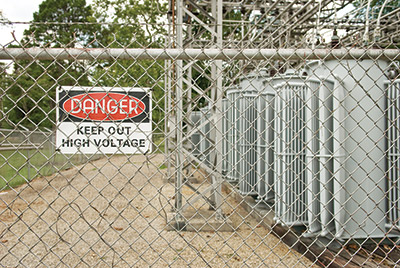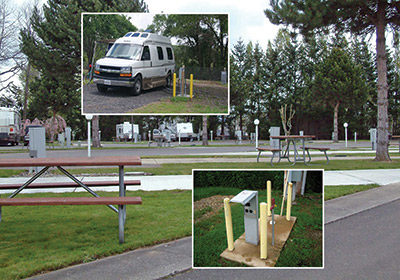It’s about that time again – the adoption of a new National Electrical Code (NEC) cycle inevitably looms over many an Authority Having Jurisdiction. Looking at the hundreds of changes in the 2014 NEC, I have picked out a handful of what I call the “Top 10 Electrical Code Changes.” It is important to remember that all code changes are important, and in no way are these particular changes more or less important than any others. I have listed what I personally believe to be ten changes that will, let’s say, cause the most discussion.
1. Article 210.8(A)(10) ALL receptacles installed in a laundry area will now require GFCI protection. It will not matter whether or not the receptacle is close to the sink, or even if there is a sink. The required laundry receptacle as well as any other receptacles in the laundry area must be GFCI-protected. It is also important to point out that Article 210.8 requires that GFCI receptacles or devices be installed in a readily accessiblelocation. If a washing machine needs to be temporarily moved over in order to reset a GFCI device, this would be a VIOLATION of code since the installation has not met the definition of readily accessible.
2. Article 210.8(D) Kitchen Dishwasher Branch Circuit – GFCI. GFCI protection must now be provided for outlets that supply dishwashers installed in dwelling unit locations. The GFCI protection must be provided whether or not the dishwasher is hardwired or receives power via cord and plug. Again, it is important to point out that a GFCI receptacle cannot be placed behind the dishwasher. This would require a person to move the appliance in order to reset the device. This would a VIOLATION, since the receptacle has not met the definition of readily accessible. A possible solution to this dilemma would be to use a blank-face GFCI device, and to place that device in a readily accessible location (somewhere in the kitchen would probably be most convenient although that is not required).
3. Article 210.12(A) Arc-Fault Circuit-Interrupter Protection, Dwelling Units. In the 2014 NEC, AFCI protection is now required in all kitchen areas and laundry areas. This is a significant change, and kitchens will now become somewhat of a “puzzle” since both GFCI and AFCI protection is required. If I were to wire a kitchen according to the 2014 NEC, I would probably accomplish this via a GFCI-protected subpanel (specifically dedicated to the kitchen), and use AFCI circuit breakers to feed the kitchen. Inspectors can now imagine the sheer joy of inspecting a kitchen rough-in wired by a homeowner who has no prior electrical-wiring experience. Of course, I’m being sarcastic to help illustrate my point. This change will inevitably give rise to more challenges for the electrical inspector, and in many cases it will be important to know at the rough-in stage just how the kitchen is to be wired. As always, I recommend that the electrical inspector allow at least 30-minutes per day in order to deal with the unexpected. On a side note, it is my understanding that there are electrical products being developed that will have both the required AFCI and GFCI protection built-in to the same breaker or device.
4. Article 230.82(3) Equipment Connected to Supply Side of Service Disconnect. A revision was made in subsection (3) of this article to require that meter disconnects (ahead of service equipment) be clearly labeled in the field to say, “METER DISCONNECT – NOT SERVICE EQUIPMENT.” Certain power company meter configurations require a disconnect ahead of the main service disconnect. This labeling will eliminate confusion that may arise as to what specific piece of equipment constitutes the service disconnect. Incidentally, the service disconnect must also be marked, see Article 230.70(B).
In order to meet Code, the labeling or marking must be able to withstand the environment involved. Simply using a pencil or non-waterproof marker outdoors will usually result in a VIOLATION. Also, simply writing the word “MAIN” may result in the job not passing the inspection. Back when I had my own company, I would use waterproof paint that came in the form of a pen, and I would always write, “SERVICE DISCONNECT.” This marking would last for years, and these words leave no room for misunderstanding.
5. Article 250.194 Grounding and Bonding of Fences and Other Metal Structures at Substations. When I first heard about this requirement, my thought was, “…but the power company is exempt!” We have to keep in mind that there are a plethora of substations on private property, under exclusive control of an owner. With this change, all metal fences located within 16 feet of the exposed electrical equipment shall be bonded to the grounding electrode system. And all metal structures (including guy wires within 8 feet vertically or 16 feet horizontally shall be bonded to the grounding electrode system. A swinging gate must be bonded to its support post, and the grounding electrode conductor must cover the full swing of the gate. The list of specific requirements can be found in Article 250.194(A).

Photo 1. Grounding and bonding of fences and other metal structures at substations
6. Article 310.15(B)(7) 120/240-Volt, Single-Phase Dwelling Services and Feeders. Table 310.15(B)(7) has been totally done away with. Now, in order to calculate the permissible size of a service conductor or feeder to an individual dwelling unit, a calculation must be performed. The ampacity values of Table 310.15(B)(16) are allowed a reduction of 17%. In other words, in order to calculate the wire size for a service, multiply the required service size by 0.83. For instance, if I require a 200-amp service: 200 amperes X 0.83 = 166 amperes. Going back to Table 310.15(B)(16), we see that the wire size for this 200-amp service would be 2/0 copper or 4/0 aluminum (for wiring rated at 75 degrees C). Under the old table, the reduction would sometimes mistakenly be applied to service conductors or feeders in parallel. This was never the intent of the Code. With the new change, it becomes clearer that the calculation is meant to apply to a single set of service conductors or feeders.
On another note, it is important to remember that this is only for sizing service conductors or feeders for dwellings. Many times I find this reduction attempted in commercial construction, which, of course, is not allowed. This would result in a VIOLATION.
7. Article 408.4(B) Source of Supply. When I was but a mere fledgling electrician, a really great inspector once told me, “Nick, one of the most important things in the Code is actually the labeling…” At the time, I thought he was crazy, but now I see things a bit differently and I agree with him 100%. The 408.4(B) marking requirement was actually in the 2011 NEC, but now the wording has been revised to clarify the intent. Switchboards, switchgear, and panelboards that are supplied by a feeder (and in other than dwellings) need to be clearly marked so as to indicate the DEVICE OR EQUIPMENT where the power originates. Keep in mind that it is possible to feed panelboards from more than one source. For example, if a panelboard is fed from a circuit breaker but is also part of an emergency system, proper marking might read, “Fed from LP1 – OR – Standby power from Generator #6.” This makes it very clear that the intent of the code is to have a person know EXACTLY where the source power may be coming from.
8. Article 450.10(A) Dry-Type Transformer Enclosures. Where separate equipment grounding conductors and supply-side bonding jumpers are installed, a terminal bar – for all bonding and grounding conductors shall be secured to the inside of the transformer enclosure. This change, in my opinion, is long overdue. Typically, many an electrician’s transformer wiring installation results in a hodgepodge of bonding and grounding conductors at different locations inside the enclosure. In many jobs that I’ve personally inspected, I would see lugs stacked upon one another – some scattered about – and even two wires being inserted into a single lug which was only listed for one wire (what inspectors commonly refer to as “double-lugging”). These things ought not be! Inspectors have to decipher what is connected to what. With this change, wiring inside transformer enclosures will result in a lot “cleaner” installation, and electricians now have a best practice of how bonding and grounding should be handled on the inside of a transformer enclosure. It should be noted that if the terminal bar is installed on or over any vented portion of the enclosure, it will result in a VIOLATION. The terminal bar must not block the vent slats in any way. This change is completely in sync with other sections of the code, such as Article 408.40 for the grounding of panelboards. A terminal bar is required! Think terminal bar!
9. Article 551.71 RV Parks – Type Receptacles Provided. As we know, every recreational vehicle site with electricity supplied to it must have at least one 20-ampere, 125-volt receptacle to supply the RV unit, conforming to the configuration as identified in Figure 551.46(C)(1). At least 20% of these sites must have one 50-ampere 125/250-volt receptacle conforming to the configuration as identified in Figure 551.46(C)(1). This change goes one step further and says that every site supplied with the 50-ampere 125/250-volt receptacle must also be supplied with a 30-ampere, 125-volt receptacle, conforming to the configuration as identified in Figure 551.46(C)(1). This change came about in order to eliminate the various types of “adapters” that have been on the market, which never take into consideration the ampacity of the RV-supply circuit that was being connected. So now if your RV is meant to have a 30-ampere supply, the proper receptacle should be there. And it is also worth mentioning that all125-volt, single-phase, 15- and 20-ampere receptacles shall have GFCI protection; this is not new.

Photo 2. RV park receptacles
10. Article 600.6(A)(1) – A disconnect for a sign is required to be located at the POINT OF ENTRY to the sign enclosure. This is another change that I feel is long overdue. Some types of signs can pose a significant hazard to the people that have to work on them. It is only common sense that the disconnect for a sign be located at the point of entry to the enclosure. I can remember my first legal case as an expert witness – it was back in 1996. Power to an electric sign was inadvertently turned on while an electrician was working on the sign. He was electrocuted, and died.
The National Electrical Code is a living, breathing document. Code changes help to increase the safety of any electrical installation. Like I said previously, all code changes are important. The ones listed here are just a few, but I believe they are very significant. Don’t stop here; take the time and familiarize yourself with the entire 2014 National Electrical Code! Many resources, such as IAEI’s Analysis of Changes, 2014 NEC, are available to help you on your journey. I hope that you share these changes with colleagues and trade professionals. In closing, I wish you all happy and safe wiring!
The comments and opinions expressed herein do not necessarily reflect the views of the Wyoming Department of Fire and Electrical Safety.















Find Us on Socials